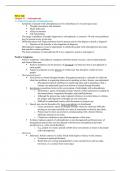Class notes
Chapter 11 - Schizophrenia
- Course
- PSYC 300A
- Institution
- University Of British Columbia (UBC )
In this comprehensive collection, we explore the complex and fascinating aspects of schizophrenia, a severe mental disorder. We delve into the diagnostic criteria, symptoms, and subtypes of schizophrenia, providing an in-depth understanding of its clinical presentation. Gain insight into the neurob...
[Show more]



